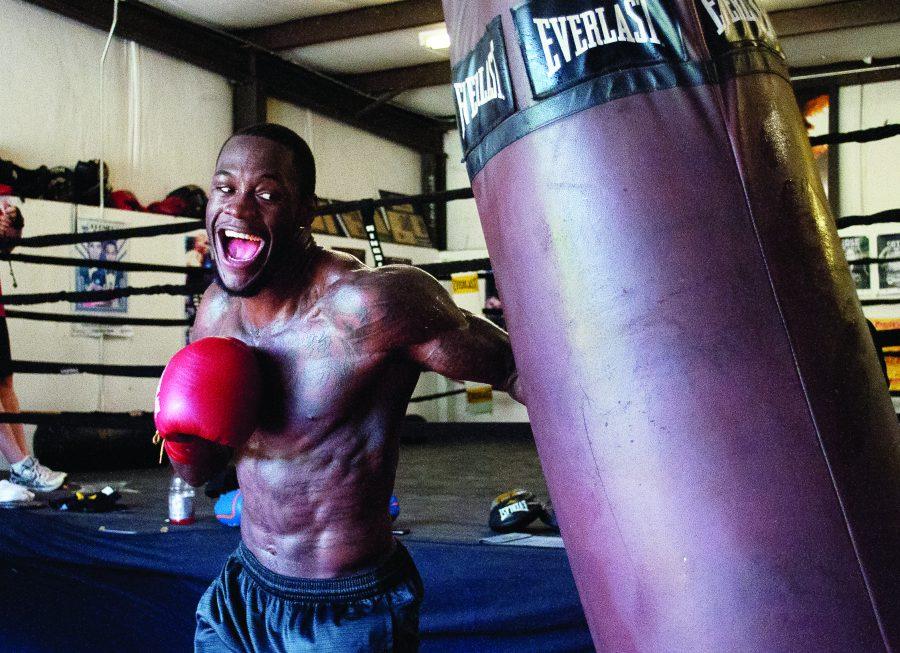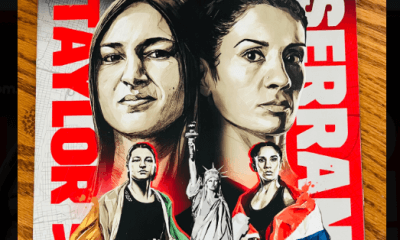Featured Articles
Is Deontay Wilder the Real Deal?

“Excuse me, Holyfield, but I am the real deal, too.”
Deontay Wilder is a fascinating individual, so there’s never a shortage of reflection-worthy material available after his media roundtables. Whether in person or on the phone, Wilder is one of the best interviews in boxing. He speaks with such joyous emotional clarity and he self- advocates with such strong and evangelical belief that even the previously mentioned Evander Holyfield would probably have agreed to share the his “Real Deal” moniker with Wilder had the fighter not already come up with his own.
But how real is he?
Wilder, aka “The Bronze Bomber,” is set to face Tyson Fury on Dec. 1 at the Staples Center in Los Angeles. It’s easily the biggest and most important fight of his career, a showdown against former unified champion Fury, who some still consider to be the lineal heavyweight champion.
“This is my time to shine,” said Wilder during that same recent media teleconference in which he compared himself to Holyfield. “This is my coming-out party–somewhere I was supposed to have been a long time ago…”
Admittedly, I’ve never quite understood how Wilder’s team landed on calling him “The Bronze Bomber.” I understand that it ties Wilder to his bronze medal winning performance in the 2008 Olympics while simultaneously paying homage to another Alabama-born fighter, the immortal Joe Louis, aka “The Brown Bomber,” but Wilder’s professional aspirations have always been to be the very best heavyweight in the world.
Why forever tie him to the legacy of coming up short?
That prophecy has been a bit self-fulfilling so far. As good as Wilder has looked over his 10-year professional career, he’s never been seen by the majority of people in boxing as anything other than the third or fourth best heavyweight in the world. To his credit, Wilder seems unfazed by it, noting that those he sees as denying the truth about what he is as a professional fighter are simply coming late to the party that is already happening.
“I was born to do this,” said Wilder. “And the more and more I have fights, and the more and more I’m able to display my talent among the world, the sooner everyone will realize that I am special. I am something that’s a gift from God.”
A gift from God? That’s a bold statement, and while God’s supposed gift to the boxing world has largely gone unappreciated by the masses, it’s hard to say right now that what Wilder says isn’t true. Just because Wilder isn’t considered the best heavyweight in world, doesn’t mean he might not be someday soon.
Still, with a glossy professional boxing record of 40 wins against zero losses, and a sparkling gold and green World Boxing Council heavyweight championship belt, Wilder often ends up being ranked behind both unified heavyweight champion Anthony Joshua and former lineal heavyweight champion Tyson Fury as the third best heavyweight titleholder in boxing.
Honestly, Wilder was probably even considered fourth best by some pundits until he knocked out Luis Ortiz in March, and it was only begrudgingly that they conceded that he was a better fighter than he appeared to be at first (or even many) glances.
From a certain point of view, Wilder’s boxing life to date has been entirely about exceeding expectations. No one in 2008 predicted Wilder, who had just started boxing in October 2005, would even come close to medaling at the Olympics. And many people were sure the previously undefeated Ortiz would be his undoing earlier this year, too. Or that it would be Bermane Stiverne before that. Or someone else before that.
Show of hands, please. How many believe Wilder will be thoroughly outboxed by Fury?
Perhaps many are raised because Wilder, 33, from Tuscaloosa, Alabama, looks more like an incredibly gifted natural athlete who just happens to beat people up for a living than he does an actual world class professional fighter. If you’ve seen any of Wilder’s fights, including his seven WBC title defenses, you probably understand why.
Wilder doesn’t fight like any other boxer.
Here are some examples, of which, many more could be put forth: He throws wide and looping punches like he’s never been taught proper form. He carries his hands down low like his brain has no concept of defense. He frequently remains still after throwing punches to admire his work rather than pivoting away from danger like any sane and reasonable person would do.
Wilder just looks–at least in comparison to pretty much every other heavyweight champion who ever lived–to be a different kind of fighter. To put it bluntly, he looks plain wrong.
I’m not sure it’s really Wilder’s fault. After all, most world champion boxers had that special someone in their lives who provided them with what in retrospect seems like a stroke of brilliance in bringing them to their local boxing gym early enough in their lives for it to matter. Even for the rare champion who has to wait for that special middle school bully to urge him into the fold, the common theme among pretty much all world champion boxers is that whatever road they took into boxing, that road came their way before they were 20 years old.
“I just do what I do,” said Wilder about his strange looking technique, one he’s used to win every single fight to date. I’ll say this about Wilder. All he does is win, and no amount of complaining about how it looks or why it shouldn’t work has affected him in the least.
That has to mean something.
Everyone who was first at doing anything was probably ridiculed for doing it wrong. While Wilder doesn’t fit the paradigm of how a heavyweight champion is supposed to look, how many more title defenses does Wilder have to win before people start admitting that maybe it’s the perception of him that is the flawed and not the fighter himself?
After all, Fury will be the most decorated and skilled fighter Wilder has ever faced. He’s a heavy puncher, possesses a great jab and knows how to use movement and defense to befuddle his opponents. Would beating Fury be enough to turn the tide?
It’s interesting to listen to Wilder talk about his unorthodox boxing style. Wilder, a gifted athlete with incredible power and insane speed says he’s more about function over form.
“Everybody can have some type of special ability about them, but if you can’t use your powers, then you’re useless.”
Wilder sure can use his, and that special ability he has is perhaps the single most important attribute any fighter can possess. Wilder knocks people out.
But Wilder doesn’t knock people out the way the boxing world is accustomed to seeing it done. While Fury is a fantastic boxer by traditional measures, it’s hard to see how well that traditional measure will work for him when it’s so obviously failed for every other single fighter who tried it on Wilder before.
More importantly, who does Fury bring in for sparring that can mimic what Wilder does?
“You’ll never find that, especially when they’re dealing with a fighter that’s awkward and don’t go by the textbook,” said Wilder. “See, I never been by the textbook. My style is what it is, and I love my style. And if somebody can come and give me a challenge and beat it, my style will always remain the same because nobody can understand it. No one could figure me out, and that what’s it all about.”
We’re all so quick to judge and point our fingers at all the things we think Wilder does wrong. That’s certainly a large part of human existence, but if he’s so terrible at boxing why is he the WBC heavyweight champ? Why is he undefeated? How did he beat Ortiz?
I’m not sure Wilder really understands what he does on fight night. I am certain almost no one else does either. Neither of those things really matter.
Just because Wilder doesn’t fight like Louis or Holyfield or any other heavyweight champion who came before him is of no consequence to Wilder. And just because the rest of us who see boxing as geometry and mathematics can’t make heads or tails about how he keeps winning fights doesn’t mean we’re all right about it anyway and that Wilder’s success is wrong because it doesn’t fit our expectations about what’s right.
Things don’t have to look real to be real. The thing that makes something real, a world class boxer or anything else, lies in its realness; not in the ability of something outside of itself to perceive that it’s real.
Maybe Wilder is the real deal after all.
Check out more boxing news on video at The Boxing Channel
-

 Featured Articles3 weeks ago
Featured Articles3 weeks agoVito Mielnicki Jr Whitewashes Kamil Gardzielik Before the Home Folks in Newark
-

 Featured Articles3 days ago
Featured Articles3 days agoResults and Recaps from New York Where Taylor Edged Serrano Once Again
-

 Featured Articles1 week ago
Featured Articles1 week agoFrom a Sympathetic Figure to a Pariah: The Travails of Julio Cesar Chavez Jr
-

 Featured Articles4 weeks ago
Featured Articles4 weeks agoCatching Up with Clay Moyle Who Talks About His Massive Collection of Boxing Books
-

 Featured Articles2 days ago
Featured Articles2 days agoResults and Recaps from NYC where Hamzah Sheeraz was Spectacular
-

 Featured Articles1 week ago
Featured Articles1 week agoCatterall vs Eubank Ends Prematurely; Catterall Wins a Technical Decision
-

 Featured Articles3 weeks ago
Featured Articles3 weeks agoMore Medals for Hawaii’s Patricio Family at the USA Boxing Summer Festival
-

 Featured Articles3 days ago
Featured Articles3 days agoPhiladelphia Welterweight Gil Turner, a Phenom, Now Rests in an Unmarked Grave


















